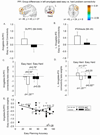Brain mechanisms of anxiety's effects on cognitive control in major depressive disorder
- PMID: 27291341
- PMCID: PMC4946974
- DOI: 10.1017/S0033291716001185
Brain mechanisms of anxiety's effects on cognitive control in major depressive disorder
Abstract
Background: Adults with major depressive disorder (MDD) demonstrate increased susceptibility to interfering effects of anxiety on cognitive control; although under certain conditions adults with MDD are able to compensate for these effects. The brain mechanisms that may facilitate the ability to compensate for anxiety either via the recruitment of additional cognitive resources or via the regulation of interference from anxiety remain largely unknown. To clarify these mechanisms, we examined the effects of anxiety on brain activity and amygdala-prefrontal functional connectivity in adults diagnosed with MDD.
Method: A total of 22 unmedicated adults with MDD and 18 healthy controls (HCs) performed the Tower of London task under conditions designed to induce anxiety, while undergoing a functional magnetic resonance imaging assessment.
Results: During the easy condition, the MDD group demonstrated equivalent planning accuracy, longer planning times, elevated amygdala activity and left rostrolateral prefrontal cortex (RLPFC) hyperactivity relative to HCs. Anxiety mediated observed group differences in planning times, as well as differences in amygdala activation, which subsequently mediated observed differences in RLPFC activation. During the easy condition, the MDD group also demonstrated increased negative amygdala-dorsolateral prefrontal cortex (DLPFC) connectivity which correlated with improved planning accuracy. During the hard condition, HCs demonstrated greater DLPFC activation and stronger negative amygdala-DLPFC connectivity, which was unrelated to planning accuracy.
Conclusions: Our results suggest that persons with MDD compensate for anxiety-related limbic activation during low-load cognitive tasks by recruiting additional RLPFC activation and through increased inhibitory amygdala-DLPFC communication. Targeting these neural mechanisms directly may improve cognitive functioning in MDD.
Keywords: Anxiety; cognitive control; depression; norepinephrine; stress.
Conflict of interest statement
Drs. Jones, Chase, and Fournier have no financial conflicts or potential conflicts of interest to disclose.
Figures




Similar articles
-
Identification of microRNA-9 linking the effects of childhood maltreatment on depression using amygdala connectivity.Neuroimage. 2021 Jan 1;224:117428. doi: 10.1016/j.neuroimage.2020.117428. Epub 2020 Oct 7. Neuroimage. 2021. PMID: 33038536
-
Resting-state functional connectivity of the amygdala and longitudinal changes in depression severity in adolescent depression.J Affect Disord. 2017 Jan 1;207:86-94. doi: 10.1016/j.jad.2016.09.026. Epub 2016 Sep 23. J Affect Disord. 2017. PMID: 27716542 Free PMC article.
-
Decoupling of the amygdala to other salience network regions in adolescent-onset recurrent major depressive disorder.Psychol Med. 2016 Apr;46(5):1055-67. doi: 10.1017/S0033291715002615. Epub 2016 Jan 20. Psychol Med. 2016. PMID: 26784396 Free PMC article.
-
Fronto-limbic neuroimaging biomarkers for diagnosis and prediction of treatment responses in major depressive disorder.Prog Neuropsychopharmacol Biol Psychiatry. 2021 Apr 20;107:110234. doi: 10.1016/j.pnpbp.2020.110234. Epub 2020 Dec 25. Prog Neuropsychopharmacol Biol Psychiatry. 2021. PMID: 33370569 Review.
-
Rethinking the Use of Neutral Faces as a Baseline in fMRI Neuroimaging Studies of Axis-I Psychiatric Disorders.J Neuroimaging. 2017 May;27(3):281-291. doi: 10.1111/jon.12403. Epub 2016 Nov 2. J Neuroimaging. 2017. PMID: 27805291 Review.
Cited by
-
Amygdala volume abnormalities and cognitive impairment in major depressive disorder and bipolar disorder II.BMC Psychiatry. 2025 Aug 28;25(1):839. doi: 10.1186/s12888-025-07313-1. BMC Psychiatry. 2025. PMID: 40877858 Free PMC article.
-
Task MRI-Based Functional Brain Network of Major Depression.Adv Exp Med Biol. 2021;1305:19-33. doi: 10.1007/978-981-33-6044-0_2. Adv Exp Med Biol. 2021. PMID: 33834392
-
Emotional Interference in Early Adolescence: Positive Reinforcement Modulates the Behavioral and Neural Effects of Negative Emotional Distracters.Cereb Cortex. 2020 Apr 14;30(4):2642-2657. doi: 10.1093/cercor/bhz266. Cereb Cortex. 2020. PMID: 31812998 Free PMC article.
References
-
- Abend R, Dan O, Maoz K, Raz S, Bar-Haim Y. Reliability, validity and sensitivity of a computerized visual analog scale measuring state anxiety. Journal of Behavior Therapy and Experimental Psychiatry. 2014;45:447–453. - PubMed
-
- Baron RM, Kenny DA. The moderator-mediator variable distinction in social psychological research: Conceptual, strategic, and statistical considerations. Journal of Personality & Social Psychology. 1986;51:1173–1182. - PubMed
-
- Bishop SJ. Trait anxiety and impoverished prefrontal control of attention. Nature Neuroscience. 2009;12:92–98. - PubMed
Publication types
MeSH terms
Grants and funding
LinkOut - more resources
Full Text Sources
Other Literature Sources
Medical

